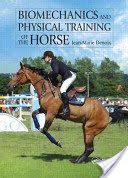Biomechanics nad Physical Training of the Horse

Mezinárodně uznávaný autor sestavil publikaci určenou trenérům, jejichž cílem je optimalizace výkonu koní ve sportu. Kniha je rozdělena do čtyř částí. V první části jsou přehledně popsány skupiny svalů a jejich funkce. V dalších částech jsou popsány biomechanické analýzy pohybu koní. Kniha je překrásně ilustrována barevnými obrázky perovkami a fotografiemi. Z textu je patrný pedagogický přístup autora, uznávaného profesora anatomie, který se zabývá pohybovým aparátem koní již několik desítek let a je autor mnoha excelentních publikací.
Autor: Jean-Marie Denoix is a worldwide authority on applied equine anatomy, biomechanics, imaging, and the clinical diagnosis of equine lameness. He is a horse rider, a qualified trotting driver, and an informed spectator of everything equestrian, dissecting all horse movements to understand their genesis and consequences
| Nakladatel | CRC Press |
|---|---|
| ISBN | 9781840761924 |
| Vydání | 2013 |
| Vazba | pevná |
| Počet stran | 191 |
Effective horse trainers strive to improve the performance of their horses while preserving the integrity of the musculoskeletal apparatus. Biomechanics and Physical Training of the Horse supplies an anatomical and functional overview of the topic, enabling trainers to optimize the different exercises their horses undergo during training and competition.
Following a brief description of the biomechanics of the muscles underlying equine movement, the book discusses the muscles of the forelimb, hindlimb, and neck and trunk. These fundamentals have direct bearing on the later chapters, which focus on training and the core exercises for a horse.
This text is illustrated throughout by the author’s top-quality photographs, diagrams, and his own beautiful anatomical drawings. The book is of lasting value to all professionals and well-informed amateurs who work with horses: veterinarians, trainers and riders, researchers, physical therapists, and educators in equine courses.
| Muscular groups and actions | 14 |
| The forelimb | 14 |
| The hindlimb | 25 |
| The neck and trunk | 39 |
| Biomechanical analysis of longitudinal movements | 52 |
| Lowering of the neck | 52 |
| Biomechanics of rein-back | 62 |
| Biomechanical analysis of lateral movements | 72 |
| The forelimbs | 72 |
| The hindlimbs | 81 |
| The vertebral column and trunk muscles | 89 |
| The biomechanical differences between half pass and shoulder-in | 98 |
| Advantages and disadvantages of lateral movements | 103 |
| Biomechanical analysis of jumping | 110 |
| Take-off and propulsion | 110 |
| Take-off and propulsion: biomechanics of the axial regions (head, neck, trunk and pelvis) | 124 |
| Airborne (flying) phase: biomechanics of the trunk and vertebral column | 133 |
| Airborne (flying) phase: biomechanics of the limbs | 142 |
| Landing phase: biomechanics of the vertebral column | 156 |
| Landing phase: biomechanics of the limbs | 165 |
| Biomechanics of the bounce jump | 177 |
| Index | 185 |